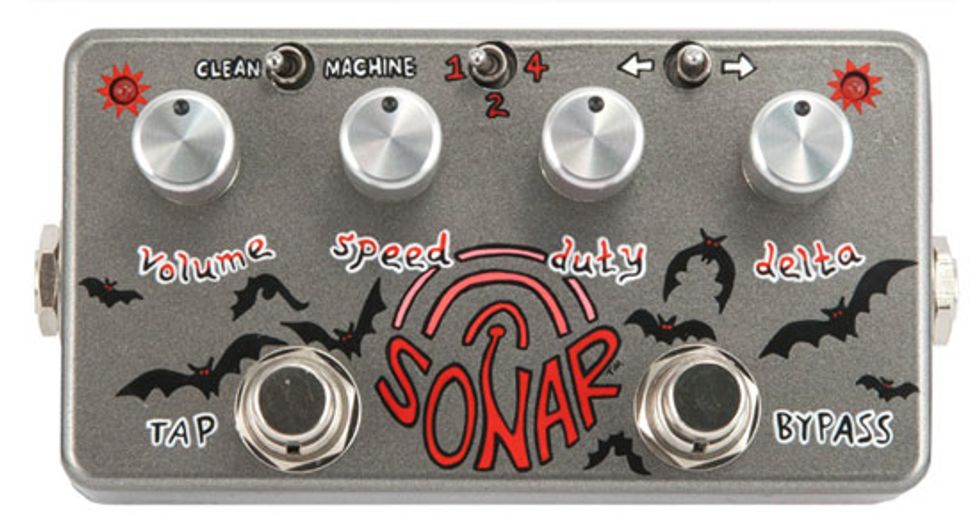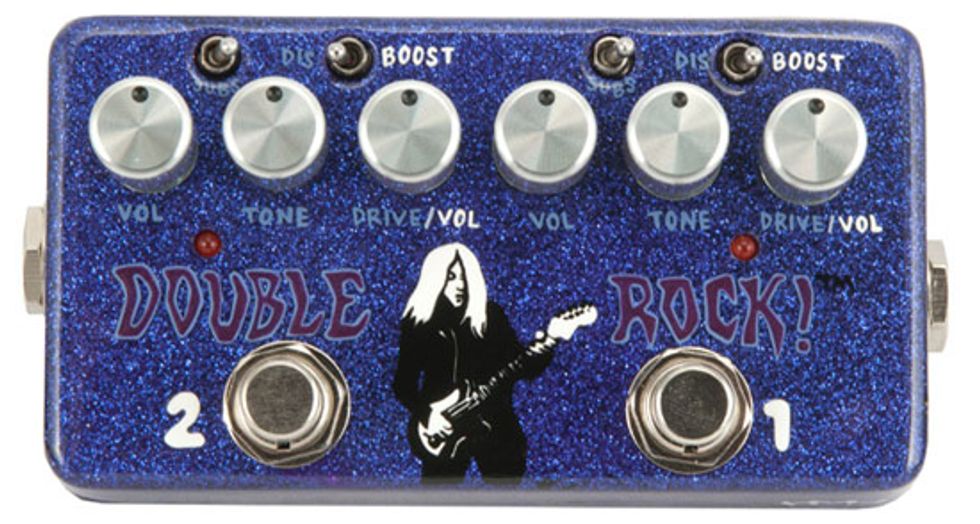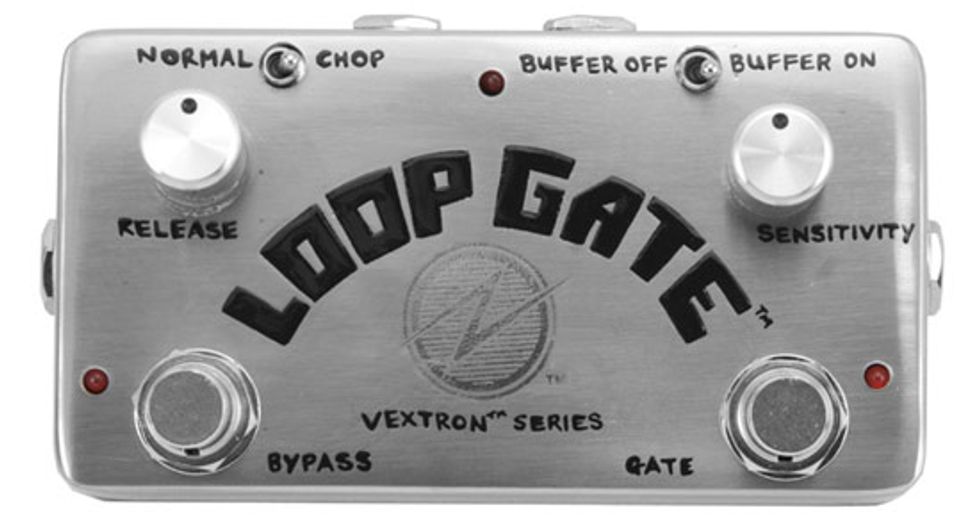The Sonar is a tremolo/machine pulser, the Double Rock was designed for J. Mascis with two Box of Rock pedals in one box, and the Loop Gate provides a loop switch with a built-in “perfect” audio gate.
Minneapolis, MN (January 17, 2012) -- Z.Vex Effects announces production prototypes for three new effects at Winter NAMM 2012: Sonar, Double Rock, and Loop Gate. Here's what Z.Vex had to say about each effect:
Sonar
The Sonar is a tremolo/machine pulser that will work with higher-gain amps, which is always a challenge. The key to this type of device is achieving absolute dead silence during the “off” time, and my engineer Joel totally pulled that off. You can easily use the Sonar BEFORE a fuzz or heavy distortion, or a very distorted amp. Plus it has a lot of special features that you’re going to love. The Sonar has four knobs and three small switches as well as two stomp switches. Here are the different modes:
1] Clean tremolo with tap tempo. One small switch allows changing time division between 1, 2 and 4, so the tap rate can be matched one-to-one, doubled, or quadrupled. There’s a volume, a speed knob if you prefer to set speed that way, and duty knob which controls the duty cycle (“on” time versus “off” time, so you can get down to very short chopped trem sounds.)
2] Machine tremolo with tap tempo, selected with the clean/machine switch. All of the above features, but the Machine pedal sound is now pulsing out of the Sonar. Just imagine how that will sound coming out of your higher-gain amp. If you’ve ever experienced a machine going through a fuzz or distortion, you’re aware of just how searing it sounds. This was the original intent with the Sonar, to give users who like dirty basic sounds the ability to sound more “penetrating” with a tremolo. Like the original Machine, the Sonar’s internal machine decays and creates that hazy rotating sound as the trem pulses on.
3] As if that isn’t weird enough, there’s another switch and knob to get super freaky-licious. This switch has three positions... the features above were described with this switch in the middle. When it’s switched to the right (“up”), there’s a knob labeled “delta” that you set how quickly the tremolo speeds up once it’s turned on. The trem will start at the rate you chose with the speed knob or tap switch, and speed up at your chosen “delta” rate until it’s screaming fast. In the same manner, the trem speed can slow down to a dead crawl at any chosen rate by switching the selector to the “down” position (to the left). You can recover the original speed by turning off and on the pedal, or simply by tapping the tap tempo switch which instantly brings it back to whatever speed you like. This speed up/slow down feature works with both the clean and machine trem sounds described above.
Double Rock!
This pedal was originally designed for J.Mascis of Dinosaur Jr. He requested two Box of Rock pedals in one box with two stomp switches (without the boosts). He uses that regularly on stage now, but we did one (or two) better with the one we’re releasing to the public... we made it so you can adjust the sub frequencies (like the Distortron), and you can convert either channel to a Super Hard-On. In this way, you can configure the pedal to be two Distortrons cascaded, two Super Hard-Ons cascaded (like a Super Duper 2-in-1™), or a Box of Rock with boost, or a Super Hard-On going into a Box of Rock. Distortion/boost heaven! Whee!!!
Loop Gate
Gating very complex sounds like fuzz and delay is always a challenge. The Loop Gate provides a loop switch with a built-in “perfect” audio gate (high headroom, no distortion, no hiss) that lets you set up a loop of pedals you can switch in and out of your signal path at will, but you have a couple of really fun options to control that loop. Let’s say you want to play a bunch of really interesting noise textures into the loop to create a giant swath of sound with echos and fuzz and perhaps a Lo-fi Loop Junky repeating some swirly, woozy phrase, and you want it to fade away perfectly when you mute the strings on your guitar. This can do that. It looks at your guitar signal to see when you want to gate. It doesn’t even bother to look at the output from your loop of pedals... that’s way too noisy to study. It’s much better to look at the incoming guitar signal to see what’s up, and that’s just what the Loop Gate does. If you want to eliminate the gate from the equation, there’s a stomp switch for that. If you want to bypass the entire loop of pedals instantly, there’s a stomp switch for that too. The release time is completely adjustable from downright slammin’ to extremely long and lovely, like the most gorgeous fadeout performed by a professional engineer. Of course, there’s a wide-ranging sensitivity control to set the turn-on threshold. And the amazing thing is, it uses the same glistening buffer found in the Lo-fi Loop Junky (the clean sound) which can be switched in and out of the circuit at the input, in case you are using a fuzz first thing in the loop and you need to have the guitar directly connected. We’ve completely perfected that buffer... it’s both velvety and glistening and has very high headroom.
BUT WAIT, that’s not all. There’s a small switch to select “chop” mode, which holds the gate open for a specific time set by the release knob, and suddenly slams shut. It won’t open again until the same period of silence has elapsed, so you can get a very interesting effect by letting your guitar sustain, where the loop gate opens and releases a blast of sound in a rhythmic pattern just like a tremolo except for one thing... you can stop playing at any moment and start again, and it will reset the start point. This is very useful for locking up the timing with the band, if you’re trying to get the tempo just right. Say the band has drifted back in tempo, and your release setting is now a little too fast. As soon as your pulses begin to creep ahead of the beat, just stop playing for a moment (say, just before 1) and start in time, and it will start with you the moment you play. Being able to bring in a whole loop of pedals with a crazy sound that is being pulsed at a precise rate and suddenly make it disappear by hitting one bypass button is very very handy for creating intense textures that need to come and go without having a switching system. While the loop is disengaged, of course, you can switch on and off pedals in the loop at your leisure, and by switching off the gate (there’s a stomp switch for that), use the bypass switch to bring the loop back in at any time.
We’re working on one more feature for this pedal over the weekend before the show. We can’t tell you what it is until we’re sure we can pull it off, but it’s very very cool.
For more information:
Z.Vex




